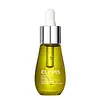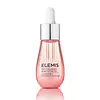What's inside
What's inside
 Key Ingredients
Key Ingredients

 Benefits
Benefits

 Concerns
Concerns

 Ingredients Side-by-side
Ingredients Side-by-side

Prunus Amygdalus Dulcis Oil
Skin ConditioningCaprylic/Capric Triglyceride
MaskingLimnanthes Alba Seed Oil
Skin ConditioningLinum Usitatissimum Seed Oil
PerfumingMacadamia Ternifolia Seed Oil
EmollientOryza Sativa Bran Oil
EmollientPapaver Orientale Seed Oil
Skin ConditioningRosa Canina Fruit Oil
EmollientSqualane
EmollientRaphanus Sativus Seed Extract
Skin ConditioningCucumis Sativus Oil
EmollientBrassica Oleracea Italica Seed Oil
EmollientParfum
MaskingLimonene
PerfumingCitrus Aurantium Dulcis Peel Oil
MaskingAmyris Balsamifera Bark Oil
MaskingCymbopogon Martini Oil
MaskingGeraniol
PerfumingLinalool
PerfumingRosmarinus Officinalis Leaf Oil
MaskingDaucus Carota Sativa Seed Oil
EmollientTocopherol
AntioxidantHelianthus Annuus Seed Oil
EmollientBenzyl Benzoate
AntimicrobialFarnesol
PerfumingCitral
PerfumingBenzyl Salicylate
PerfumingRosmarinus Officinalis Leaf Extract
AntimicrobialPrunus Amygdalus Dulcis Oil, Caprylic/Capric Triglyceride, Limnanthes Alba Seed Oil, Linum Usitatissimum Seed Oil, Macadamia Ternifolia Seed Oil, Oryza Sativa Bran Oil, Papaver Orientale Seed Oil, Rosa Canina Fruit Oil, Squalane, Raphanus Sativus Seed Extract, Cucumis Sativus Oil, Brassica Oleracea Italica Seed Oil, Parfum, Limonene, Citrus Aurantium Dulcis Peel Oil, Amyris Balsamifera Bark Oil, Cymbopogon Martini Oil, Geraniol, Linalool, Rosmarinus Officinalis Leaf Oil, Daucus Carota Sativa Seed Oil, Tocopherol, Helianthus Annuus Seed Oil, Benzyl Benzoate, Farnesol, Citral, Benzyl Salicylate, Rosmarinus Officinalis Leaf Extract
Caprylic/Capric Triglyceride
MaskingIsoamyl Cocoate
Coco-Caprylate
EmollientSimmondsia Chinensis Seed Oil
EmollientPrunus Amygdalus Dulcis Oil
Skin ConditioningParfum
MaskingCocos Nucifera Oil
MaskingOleic/Linoleic/Linolenic Polyglycerides
EmollientHelianthus Annuus Seed Oil
EmollientCitronellol
PerfumingGeraniol
PerfumingLaminaria Digitata Extract
Skin ProtectingRosa Canina Fruit Oil
EmollientCarthamus Tinctorius Seed Oil
MaskingTocopherol
AntioxidantBenzyl Salicylate
PerfumingRose Extract
Skin ConditioningSalicornia Herbacea Extract
Skin ConditioningPadina Pavonica Thallus Extract
Skin ConditioningPelargonium Graveolens Oil
MaskingRosa Damascena Flower Oil
MaskingRosa Damascena Extract
MaskingCaprylic/Capric Triglyceride, Isoamyl Cocoate, Coco-Caprylate, Simmondsia Chinensis Seed Oil, Prunus Amygdalus Dulcis Oil, Parfum, Cocos Nucifera Oil, Oleic/Linoleic/Linolenic Polyglycerides, Helianthus Annuus Seed Oil, Citronellol, Geraniol, Laminaria Digitata Extract, Rosa Canina Fruit Oil, Carthamus Tinctorius Seed Oil, Tocopherol, Benzyl Salicylate, Rose Extract, Salicornia Herbacea Extract, Padina Pavonica Thallus Extract, Pelargonium Graveolens Oil, Rosa Damascena Flower Oil, Rosa Damascena Extract
 Reviews
Reviews

Ingredients Explained
These ingredients are found in both products.
Ingredients higher up in an ingredient list are typically present in a larger amount.
Benzyl Salicylate is a solvent and fragrance additive. It is an ester of benzyl alcohol and salicylic acid. This ingredient can be naturally found in some plants and plant extracts.
In fragrances, Benzyl Salicylate may be a solvent or a fragrance component. In synthetic musk scents, it is used as a solvent. For floral fragrances such as lilac and jasmine, it is used as a fragrance component. The natural scent of Benzyl Salicylate is described as "lightly-sweet, slightly balsamic".
While Benzyl Salicylate has been associated with contact dermatitis and allergies, emerging studies show it may not be caused by this ingredient alone.
However, this ingredient is often used with fragrances and other components that may cause allergies. It is still listed as a known allergen in the EU. We recommend speaking with a professional if you have concerns.
Another study from 2021 shows Benzyl Salicylate may have anti-inflammatory properties.
Learn more about Benzyl SalicylateThis ingredient is an emollient, solvent, and texture enhancer. It is considered a skin-softener by helping the skin prevent moisture loss.
It helps thicken a product's formula and makes it easier to spread by dissolving clumping compounds.
Caprylic Triglyceride is made by combining glycerin with coconut oil, forming a clear liquid.
While there is an assumption Caprylic Triglyceride can clog pores due to it being derived from coconut oil, there is no research supporting this.
Learn more about Caprylic/Capric TriglycerideGeraniol is used to add fragrance/parfum to a product. It is the main component of citronellol. It is a monoterpenoid and an alcohol.
Monoterpenes are naturally found in many parts of different plants.
Geraniol can be found in many essential oils including Rose Oil and Citronella Oil. The scent of Geraniol is often described as "rose-like". Many foods also contain Geraniol for fruit flavoring.
Geraniol can irritate the skin when exposed to air. However, irritation depends on the ability of geraniol to penetrate into the skin. In general, geraniol is not able to penetrate skin easily.
Geraniol is colorless and has low water-solubility. However, it is soluble in common organic solvents.
Like citronellol, it is a natural insect repellent.
2,6-Octadien-1-ol, 3,7-dimethyl-, (2E)-
Learn more about GeraniolHelianthus Annuus Seed Oil is the oil derived from the seeds of a Sunflower. Sunflower seed oil is non-fragrant. It is an emollient, meaning it helps to soften the skin.
Sunflower seed oil contains many fatty acids. The fatty acids found in sunflower seeds include (from highest amount to least): linoleic acid, myristic acid, palmitic acid, stearic acid, arachidic acid, oleic acid, and linolenic acid.
These fatty acids help the skin create ceramides. Ceramides play a role in repairing the skin barrier.
Helianthus Annuus Seed Oil helps moisturize the skin. This in turn helps the skin look more rejuvenated and smoother.
Sunflowers are rich in vitamin E.
Historians believe Indigenous cultures of North America domesticated sunflowers before corn. Thus they relied on sunflower oil for a variety of uses. One such use is moisturizing skin and hair.
Sunflower seed oil may not be fungal acne safe. We recommend speaking with a professional if you have any concerns.
Learn more about Helianthus Annuus Seed OilParfum is a catch-all term for an ingredient or more that is used to give a scent to products.
Also called "fragrance", this ingredient can be a blend of hundreds of chemicals or plant oils. This means every product with "fragrance" or "parfum" in the ingredients list is a different mixture.
For instance, Habanolide is a proprietary trade name for a specific aroma chemical. When used as a fragrance ingredient in cosmetics, most aroma chemicals fall under the broad labeling category of “FRAGRANCE” or “PARFUM” according to EU and US regulations.
The term 'parfum' or 'fragrance' is not regulated in many countries. In many cases, it is up to the brand to define this term.
For instance, many brands choose to label themselves as "fragrance-free" because they are not using synthetic fragrances. However, their products may still contain ingredients such as essential oils that are considered a fragrance by INCI standards.
One example is Calendula flower extract. Calendula is an essential oil that still imparts a scent or 'fragrance'.
Depending on the blend, the ingredients in the mixture can cause allergies and sensitivities on the skin. Some ingredients that are known EU allergens include linalool and citronellol.
Parfum can also be used to mask or cover an unpleasant scent.
The bottom line is: not all fragrances/parfum/ingredients are created equally. If you are worried about fragrances, we recommend taking a closer look at an ingredient. And of course, we always recommend speaking with a professional.
Learn more about ParfumPrunus Amygdalus Dulcis Oil comes from the sweet almond, a tree native to Iran. This oil has no fragrance and is non-volatile.
Almonds contain healthy fats, vitamins, and minerals. It is a rich source of Vitamin E, a great antioxidant and skin conditioning ingredient. Sweet almond oil contains fatty acids such as linolenic acid and triglycerides.
The content of sweet almond oil makes it a great emollient; it can help soften and hydrate your skin. Emollients create a barrier over your skin to trap moisture in. Sweet almond oil has antioxidant properties.
Those with an almond allergy should be careful of this ingredient and speak with a professional about using it in your skincare.
This ingredient may not be fungal-acne safe.
Learn more about Prunus Amygdalus Dulcis OilRosehip Oil is a non-fragrant plant oil. Rosehips are a fruit from a rose bush and are edible. This oil has skin conditioning and hydrating properties.
Rosehip contains Vitamin C, Vitamin E, fatty acids and linolenic acids. These nourish your skin barrier. Having hydrated skin may help reduce the appearance of fine-lines and wrinkles.
Another great component of Rosehip Oil is Vitamin A, or retinol. Vitamin A encourages your skin to create more collagen.
Rosehip oil may help with reducing pigmentation. The lycopene and beta-carotene have skin-lightening properties. However, more studies are needed to confirm this.
Learn more about Rosa Canina Fruit OilTocopherol (also known as Vitamin E) is a common antioxidant used to help protect the skin from free-radicals and strengthen the skin barrier. It's also fat soluble - this means our skin is great at absorbing it.
Vitamin E also helps keep your natural skin lipids healthy. Your lipid skin barrier naturally consists of lipids, ceramides, and fatty acids. Vitamin E offers extra protection for your skin’s lipid barrier, keeping your skin healthy and nourished.
Another benefit is a bit of UV protection. Vitamin E helps reduce the damage caused by UVB rays. (It should not replace your sunscreen). Combining it with Vitamin C can decrease sunburned cells and hyperpigmentation after UV exposure.
You might have noticed Vitamin E + C often paired together. This is because it is great at stabilizing Vitamin C. Using the two together helps increase the effectiveness of both ingredients.
There are often claims that Vitamin E can reduce/prevent scarring, but these claims haven't been confirmed by scientific research.
Learn more about Tocopherol